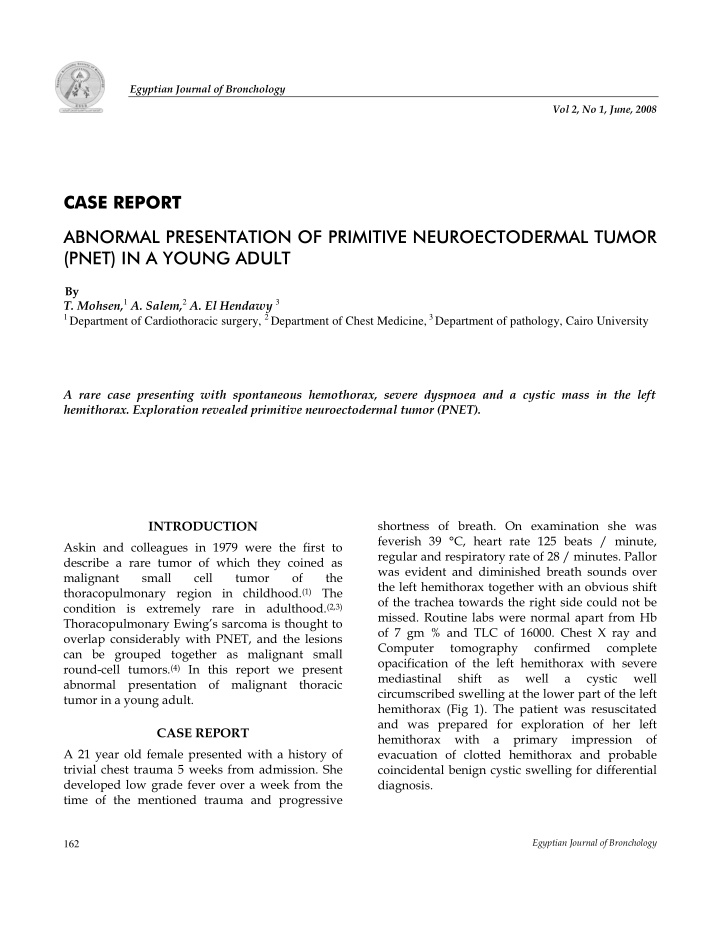



Egyptian Journal of Bronchology Vol 2, No 1, June, 2008 CASE REPORT ABNORMAL PRESENTATION OF PRIMITIVE NEUROECTODERMAL TUMOR (PNET) IN A YOUNG ADULT By T. Mohsen, 1 A. Salem, 2 A. El Hendawy 3 1 Department of Cardiothoracic surgery, 2 Department of Chest Medicine, 3 Department of pathology, Cairo University A rare case presenting with spontaneous hemothorax, severe dyspnoea and a cystic mass in the left hemithorax. Exploration revealed primitive neuroectodermal tumor (PNET). INTRODUCTION shortness of breath. On examination she was feverish 39 °C, heart rate 125 beats / minute, Askin and colleagues in 1979 were the first to regular and respiratory rate of 28 / minutes. Pallor describe a rare tumor of which they coined as was evident and diminished breath sounds over malignant small cell tumor of the the left hemithorax together with an obvious shift thoracopulmonary region in childhood. (1) The of the trachea towards the right side could not be condition is extremely rare in adulthood. (2,3) missed. Routine labs were normal apart from Hb Thoracopulmonary Ewing’s sarcoma is thought to of 7 gm % and TLC of 16000. Chest X ray and overlap considerably with PNET, and the lesions Computer tomography confirmed complete can be grouped together as malignant small opacification of the left hemithorax with severe round-cell tumors. (4) In this report we present mediastinal shift as well a cystic well abnormal presentation of malignant thoracic circumscribed swelling at the lower part of the left tumor in a young adult. hemithorax (Fig 1). The patient was resuscitated and was prepared for exploration of her left CASE REPORT hemithorax with a primary impression of A 21 year old female presented with a history of evacuation of clotted hemithorax and probable trivial chest trauma 5 weeks from admission. She coincidental benign cystic swelling for differential developed low grade fever over a week from the diagnosis. time of the mentioned trauma and progressive Egyptian Journal of Bronchology 162
Fig 1 At Exploration a large rather firm mass was found arising from the diaphragm, ruptured and oozing blood (Fig 2). Blood clots were removed from the left hemithorax and the mass could be excised completely and primary closure of the diaphragm edges (Fig 3). Post operative irradiation was given and the patient was followed for one year without recurrence. Fig 3 Fig 2 EJB, Vol 2, No 1, June, 2008 163
COMMENT 4. Sawin RS, Conrad EU, Park JR, Waldhausen JHT. Preresection chemotherapy improves survival for children Primitive neuroectodermal tumor lesions are with Askin tumors. Arch Surg. 1996;131:877-80. aggressive and usually lethal; they should be 5. Bourque MD, DiLorenzo M, Collin PP, et al. Malignant considered in the differential diagnosis of thoracic small-cell tumor of the thoracopulmonary region (Askin tumors. They were primary described in tumor). J Pediatr Surg. 1989;24:1079-83. childhood but are considered rare in adults. 6. Takahashi K, Dambara T, Uekusa T, Nukiwa T, Kira S. Massive chest wall tumor diagnosed as Askin tumor: Lesions of PNET are typically painful, invasive successful treatment by intensive combined modality therapy in an adult. Chest. 1993;104:287-8. thoracic tumors that may develop on and invade the chest wall, lung, or mediastinum. They are generally soft and fleshy, with areas of hemorrhage and necrosis. Although the tumors were classified by Askin and colleagues (1) with thoracic autonomic neurogenic tumors, the PNET cells do not produce biologically active substances detectable in the blood or urine. A similar chromosomal translocation occurring in both Ewing’s sarcoma and PNET lesions suggests that these tumors are closely related. Characteristic PNET pathologic findings include Homer-Wright pseudorosettes and uptake of neuron-specific enolase stain. (5) Although the estimated life expectancy is less than 1 year, aggressive surgery and multimodality regimen has led to disease free survivors. (4-6) In our present case we report abnormal presentation of a rare malignant mass presenting in a young adult. The patient was aggressively managed with radical excision followed by radiotherapy. She was followed for the past year without any recurrence. PNET should be aggressively managed with multimodality therapy to improve survival. REFERENCES 1. Askin FB, Rosai J, Sibley RK, Dehner LP, McAlister WH. Malignant small cell tumor of the thoracopulmonary region in childhood. Cancer. 1979;43:2438-51. 2. Shamberger RC, Tarbell NJ, Perez-Atayde AR, Grier HE. Malignant small round cell tumor (Ewing’s-PNET) of the chest wall in children. J Pediatr Surg. 1994;29:179-85. 3. Baumgartner FJ, Omari BO, French SW. Primitive neuroectodermal tumor of the pulmonary hilum in an adult. Ann Thorac Surg. 2001;72:285-7. Egyptian Journal of Bronchology 164
Recommend
More recommend